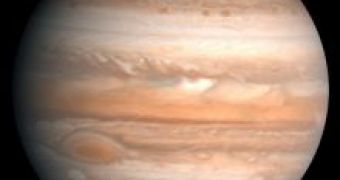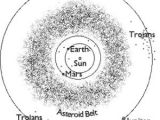Astronomers have found a bound pair of icy comets similar to the dirty snowballs circling the Sun outside the orbit of Neptune lurking in the shadow of Jupiter. Scientists think that the dirty snowballs have formed in the outer reaches of the solar system, but due to the chaotic gravitational influences from one another, some of them occasionally move closer to the sun and become comets.
The team suggests that the asteroid discovered around Jupiter probably formed far from the Sun and that Jupiter captured it during an early phase of the solar system, around 650 million years after its formation (the solar system is 5 billion years old), when many comets approached the inner solar system. Jupiter has two so-called Trojan points - two gravitational eddies collecting debris. These points are places were the gravitational attraction of the Sun and Jupiter are balanced, allowing debris to collect like dust bunnies in the corner of a room. The location of the Trojan asteroids is described in the image below.
This discovery could mean that many or most of the probably thousands of Jupiter's Trojan asteroids are dirty snowballs that originated much farther from the sun and at the same time as the objects now occupying the Kuiper Belt. "It's our suspicion that the Trojans are small Kuiper Belt objects," said study leader Franck Marchis, a research astronomer at UC Berkeley.
This discovery supports a recent hypothesis put forth by a group of researchers headed by Alessandro Morbidelli, a theoretical astronomer with the Conseil National de la Recherche Scientifique laboratory of the Observatoire de la Cote d'Azur, Nice, France.
According to this hypothesis during the early history of the solar system icy comets have been captured in Jupiter's Trojan points and during the first few hundred million years after the birth of the solar system the large gas planets orbited closer to the Sun, enveloped in a cloud of billions of large asteroids called planetesimals, perhaps 100 kilometers in diameter or less. Interactions with these planetesimals caused the large gaseous planets to migrate outward until about 3.9 billion years ago, when Jupiter and Saturn entered resonant orbits and began tossing the planetesimals around like confetti, some of them leaving the solar system for good.
The bulk of the remaining planetesimals settled into orbits beyond Neptune forming the Kuiper Belt - the source of short-period comets - but a small number were captured in the Trojan eddies of the giant planets, in particular Jupiter.
"This is the first time anyone has determined directly the density of a Trojan asteroid, and it supports the new scenario proposed by Morbidelli," said coauthor Daniel Hestroffer, an astronomer at the IMCEE. They have found that the density of the asteroid is similar to that of Kuiper Belt objects suggesting it originated there. The traditional theory about the Trojan asteroids says they formed near Jupiter while the planet itself was coming together. In that case, they would have been expected to have a rock and ice composition similar to the Jovian moons Callisto and Ganymede and not one similar to the Kuiper Belt objects.
The astronomers used the new adaptive optics laser system described in more detail here. The laser guide star system uses a laser beam to excite sodium atoms within a small spot in the upper atmosphere. This artificial "star" is used to measure atmospheric turbulence, which is then removed by the movable mirrors of the Keck adaptive optics system. "Before, we could only look at objects near a bright reference star, limiting the use of adaptive optics to a small percentage of the heavens," Marchis said. "Now, we can use adaptive optics to view almost any point on the sky."

 14 DAY TRIAL //
14 DAY TRIAL // 
